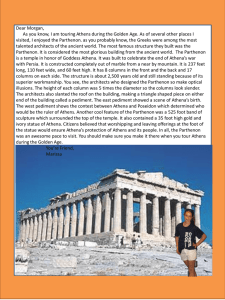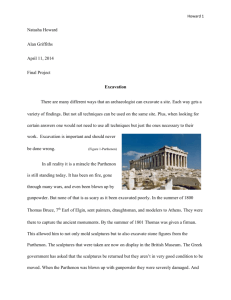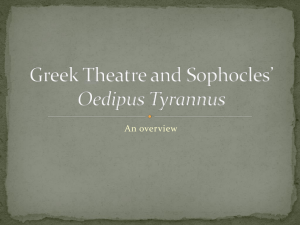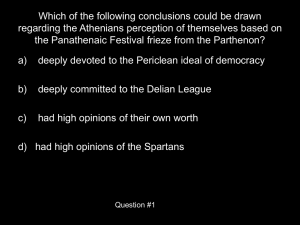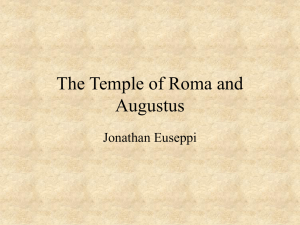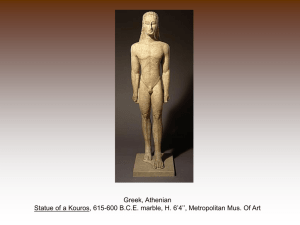SECRETS OF THE PARTHENON FILM STUDY GUIDE
advertisement
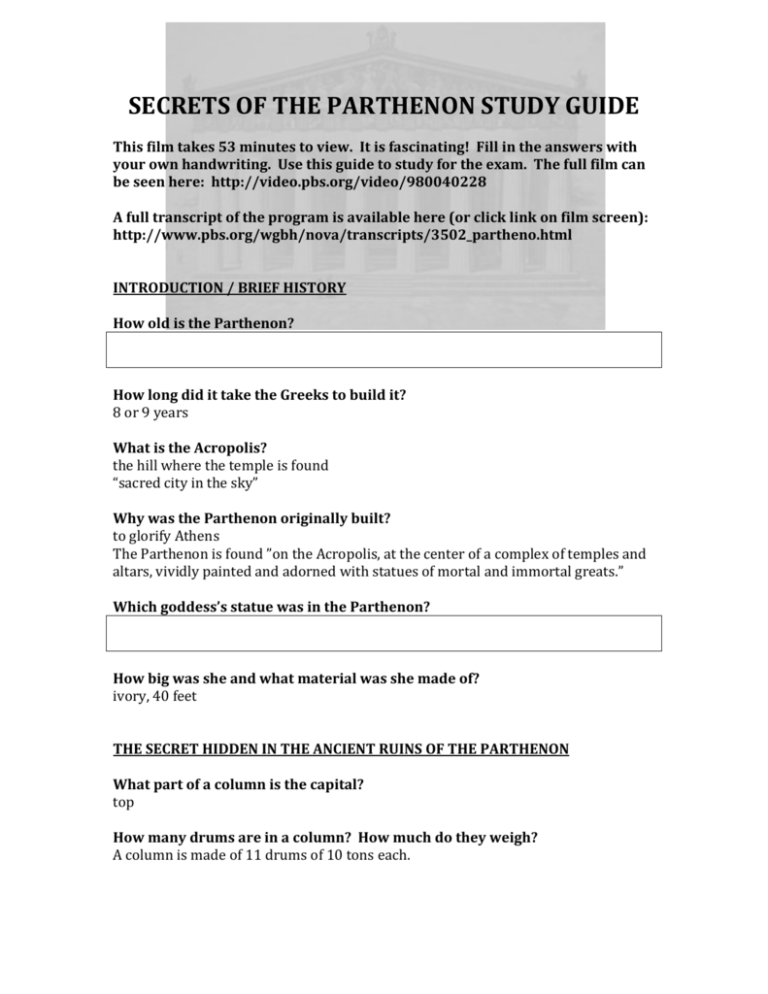
SECRETS OF THE PARTHENON STUDY GUIDE This film takes 53 minutes to view. It is fascinating! Fill in the answers with your own handwriting. Use this guide to study for the exam. The full film can be seen here: http://video.pbs.org/video/980040228 A full transcript of the program is available here (or click link on film screen): http://www.pbs.org/wgbh/nova/transcripts/3502_partheno.html INTRODUCTION / BRIEF HISTORY How old is the Parthenon? How long did it take the Greeks to build it? 8 or 9 years What is the Acropolis? the hill where the temple is found “sacred city in the sky” Why was the Parthenon originally built? to glorify Athens The Parthenon is found ”on the Acropolis, at the center of a complex of temples and altars, vividly painted and adorned with statues of mortal and immortal greats.” Which goddess’s statue was in the Parthenon? How big was she and what material was she made of? ivory, 40 feet THE SECRET HIDDEN IN THE ANCIENT RUINS OF THE PARTHENON What part of a column is the capital? top How many drums are in a column? How much do they weigh? A column is made of 11 drums of 10 tons each. What is the secret hidden in these ancient ruins? What is the stylobate? Is it straight on the Parthenon? Describe. The stylobate is the foundation. It is 6 ¾ cm off from a straight line. How many columns are there in the Parthenon? Are they straight? Describe. The 46 columns are gently curved (bulge in the middle) and slightly lean in. What is an architrave? Is it straight on the Parthenon? Describe. The architraves (marble beams across tops of columns) are curved. ACROPOLIS RESTORATION PROJECT “The Parthenon was the greatest monument in the greatest sanctuary in the greatest city of classical Greece. It was the central repository of the Athenians' lofty conception of themselves and the physical—marble—embodiment of their values, their beliefs, their myths, their ideologies. It was as much a temple to Athens and the Athenians as it is to their patron goddess, Athena Parthenos.” What happened 30 years before the Parthenon was built? Athens defeated the Persians, led by Xerxes. Who is the Greek leader who uses funds from the Greek city-states in around 450 BCE to pay for a rebuilding of Athens that ushers in the Golden Age of Greece? What is the Greek origin of the word democracy? "demos" meaning "people," and "cratos," "power"— people power, or democracy. Near the acropolis is where the first voting happened. How many citizens voted in Athenian democracy? 30 to 40 thousand Philosophy and theater flourished. What is the name of the theater on the south slope of the Acropolis? theater of Dionysus The Acropolis was in ruins. What was the democratic vote: leave it or rebuild it? Rebuild. CLUES FROM NAXOS Of what material was the Parthenon made? marble (polished when completed) What is the explanation for the curves? Greeks were aware of optical illusions. What kind of perfection was most important to the Greeks in building the Parthenon? Hint: it is NOT mathematical perfection. How did the government inform the people of the amount of money it spent? publicly on stone What body part did the ancient Greeks use to measure? the foot A “perfect, ideal human body, designed by nature, is a kind of paradigm for how architects should design temples.” What did Vitruvius, in the first century B.C.E., and Leonardo, in the Renaissance, believe to be the measure of the ideal? the human body, in particular the ratio of arm span to height “The ratio of the radius of the circle to a side of the square is 1 to 1.6. That ratio is sometimes attributed to the Greek mathematician, Pythagoras, who lived 100 years before the building of the Parthenon. In the Victorian age, it became known as the ‘golden ratio.’ It was a mathematical formula for beauty. For centuries many scholars believed the golden ratio gave the Parthenon its tremendous power and perfect proportions. Most notably, the ratio of height to width on its facades is a golden ratio. Today the golden ratio's use in the Parthenon has been largely discredited, but Manolis Korres and most scholars believe another ratio does in fact appear in much of the building.” What is the ratio scholars discovered throughout the Parthenon? Give examples. 4:9 ratio The width, for instance, is 30 meters and 80 centimeters; the length is 69 meters and 51 centimeters, the ratio being 4:9. The 4:9 ratio is also found between the width of the columns and the distance between their centers, and the height of the facade to its width. What is symmetria? What did Protagoras have to say about measurement? PRECISION What is sand used for when building the Parthenon? to subtly sand down the marble on the drums to fit perfectly What was cedar wood used for? block (dowel) in center of drums ENTASIS What does entasis mean? Give some examples in the Parthenon. curvature that gives tension; gives “life” like curvature of human body subtle outward curve of column stylobate and architrave are curved (mentioned earlier) How did they design columns with entasis so precisely? Inscribed a template with the radius measurements in the marble. What year was the Parthenon completed? What are the adornments on the Parthenon? “NARRATOR: As the ultimate expression of Athenian ideals, the temple is adorned with mythological battles of victory: justice over injustice, civilization defeating barbarity, order prevailing over chaos. And, perhaps for the first time on a Greek temple, the Athenians, mere mortals, depict themselves alongside the gods. JEFFREY M. HURWIT: And so, if the human beings, the Athenians on the Parthenon frieze, are elevated near the rank of gods, the gods are represented in a way that makes them human. And the difference between gods and mortals, between Athenians and the Olympians is not one so much of kind, as of degree. This is an extremely humanistic way of representing themselves.” What happened to the Athena statue one year after the Parthenon was built? Pericles offered to strip her gold to fund a war against Sparta. The Spartans crushed the Athenians and turned the Parthenon into army barracks. Where are the Elgin marbles today? British Museum (named after Lord Elgin, who “procured” the marbles between 1801 and 1812) OTHER RESOURCES Take a quick visit to Unit 2 Links on the web site or put these URLs into your browser to see: A) the full-scale replica of the Athena statue in Nashville http://www.imago.iwarp.com/athena.html B) the full-scale replica of the Parthenon in Nashville with a full-size replica of Athena inside and entasis faithfully reproduced [NOTE: You have to wait for the slide shows to play. There aren’t any buttons. If you only have time for one, look at the exterior photos slide show (top right link).] http://www.nashville.gov/parthenon/PhotoGallery.asp and http://www.nashville.gov/Parthenon/Athena/index.asp and C) examples of the gaudy colors painted on the original Greek statues, including the Parthenon GODS IN COLOR: gallery exhibition reconstructing the colors of original Greek sculptures http://christogenea.org/resources/Harvard%20gods%20in%20color%20gallery% 20guide.pdf MORE ON GODS IN COLOR from the Archaeological Institute of America http://www.archaeology.org/0801/trenches/colorgods.html GODS IN COLOR: an excellent article from Smithsonian Magazine http://www.smithsonianmag.com/arts-culture/true-colors.html?c=y&page=1# HARVARD MAGAZINE article on "Gods in Color" exhibit http://harvardmagazine.com/2007/11/dazzlers.html
